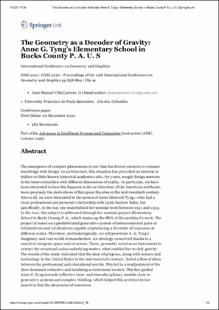Mostrar el registro sencillo del ítem
The Geometry as a Decoder of Gravity: Anne G. Tyng’s Elementary School in Bucks County P. A. U. S
| dc.contributor.author | Villa Carrero, Juan Manuel | |
| dc.date.accessioned | 2021-12-07T16:56:23Z | |
| dc.date.available | 2021-12-07T16:56:23Z | |
| dc.date.issued | 2020-12-02 | |
| dc.identifier.uri | http://repositorio.ufps.edu.co/handle/ufps/1717 | |
| dc.description.abstract | The emergence of complex phenomena in our time has forced creators to connect knowledge with design. In architecture, this situation has provoked an interest in hidden or little-known historical academics who, for years, sought design answers in the interconnection with different dimensions of reality. In particular, we have been interested in how this happens in the architecture of the American northeast, more precisely the derivations of European theories in the mid-twentieth century. Above all, we were interested in the person of Anne Griswold Tyng,—who had a close professional and personal relationship with Louis Isadore Kahn, but specifically, in the way she materialized her seminal work between 1951 and 1953. In the text, this subject is addressed through her seminal project Elementary School in Bucks County P. A., which makes up the DNA of this architect’s work. The project is based on a prefabricated generative system of interconnected parts of tetrahedrons and octahedrons capable of producing a diversity of responses at different scales. Therefore, methodologically, we will penetrate A. G. Tyng’s imaginary and real-world of manufacture. An ideology conceived thanks to a search to integrate space and structure. There, geometry acted as an instrument to extract the structural codes underlying matter, what enabled her to defy gravity. The results of the study indicated that the ideal of progress, along with science and technology in the United States in the mid-twentieth century, fueled a flow of ideas between the professional and educational worlds. This led to a readjustment of the then-dominant reductive and totalizing architectural models. This fact guided Anne G. Tyng towards reflective inter- and transdisciplinary models close to generative systems and complex thinking, which helped this architect in her search to find the structures of tomorrow | eng |
| dc.format.mimetype | application/pdf | spa |
| dc.language.iso | eng | spa |
| dc.publisher | Advances in Intelligent Systems and Computing | spa |
| dc.relation.ispartof | Advances in Intelligent Systems and Computing | |
| dc.rights | © The Author(s), under exclusive license to Springer Nature Switzerland AG 2021 | eng |
| dc.source | https://link.springer.com/chapter/10.1007/978-3-030-63403-2_78 | spa |
| dc.title | The Geometry as a Decoder of Gravity: Anne G. Tyng’s Elementary School in Bucks County P. A. U. S | eng |
| dc.type | Artículo de revista | spa |
| dcterms.references | Kahn, L.I.: New frontiers in architecture CIAM in Otterlo 1959. In: Escritos de Louis I Kahn, from Alessandra Latour, pp. 91–110. El Croquis Editorial, Madrid (2003) | spa |
| dcterms.references | Philadelphia Chapter of the American Institute of Architects: Structure for a classroom unit. In: Kling, V.G., Buchler, J., Carvin, M. (eds.) Year Book. AIA, Philadelphia (1952) | spa |
| dcterms.references | Buckminster, F.R.: Your private sky R. buckminster fuller art design science. In: Krausse, J., Lichetenstein, C. (eds.) Lars Muller Publisher, Baden (1999) | spa |
| dcterms.references | Tyng, A.G.: Resonance between eye and archetype. In: Reed, A.G., Doo, P.C., Burton, J. (eds.) Via 6 Architecture and Perception - University of Pennsylvania Graduate Students in Architecture, pp. 47–67. MIT Press (1983) | spa |
| dcterms.references | Tyng, A.G.: Urban space systems as living form: Part 1. Archit. J. R. Archit. Inst. Canada 45(11) 45–54 (1968) | spa |
| dcterms.references | Edmondson, A.C.: A Fuller Explanation. The Synergetic Geometry of R. Buckminster Fuller. Birkhauser, Boston-Basel- Stuttgart (1987) | spa |
| dcterms.references | Fuller, R.B.: Synergetic Exploration in the Geometry of Thinking. Macmillan, New York (1975) | spa |
| dcterms.references | Tyng, A.G.: Interview of Alessandra Latour with Anne Griswold Tyng, p. 49, 2 May 1982 | spa |
| dcterms.references | Kahn, L.I.: La monumentalidad (1944). In: Kahn, L.I. (eds.) escritos, conferencias y entrevistas, from Alessandra Latour, pp. 23–33. El Croquis Editorial, Madrid (2003) | spa |
| dcterms.references | Tyng, A.G.: Entrevista de Robert Kirkbride. Tyng, A.: Number is form and form is number. Nexus Netw. J. (2005) | spa |
| dcterms.references | Architectural Forum: Buckminster Fuller “Geodesic Dome”. Architectural Forum, Agosto, pp. 144–151 (1951) | spa |
| dcterms.references | The Charette: Design by Triangulation. The Charette XXXII, nº 9, pp. 14–15 (1953) | spa |
| dc.identifier.doi | https://doi.org/10.1007/978-3-030-63403-2_78 | |
| dc.publisher.place | Berlin , Alemania | spa |
| dc.relation.citationedition | Vol.1296 (2020) | spa |
| dc.relation.citationendpage | 869 | spa |
| dc.relation.citationstartpage | 858 | spa |
| dc.relation.citationvolume | 1296 | spa |
| dc.relation.cites | Carrero J.M.V. (2021) The Geometry as a Decoder of Gravity: Anne G. Tyng’s Elementary School in Bucks County P. A. U. S. In: Cheng LY. (eds) ICGG 2020 - Proceedings of the 19th International Conference on Geometry and Graphics. ICGG 2021. Advances in Intelligent Systems and Computing, vol 1296. Springer, Cham. https://doi.org/10.1007/978-3-030-63403-2_78 | |
| dc.relation.ispartofjournal | Advances in Intelligent Systems and Computing | spa |
| dc.rights.accessrights | info:eu-repo/semantics/restrictedAccess | spa |
| dc.subject.proposal | Anne G. Tyng | eng |
| dc.subject.proposal | Louis I. Kahn | eng |
| dc.subject.proposal | Geometry | eng |
| dc.subject.proposal | Structure | eng |
| dc.subject.proposal | Seminal | eng |
| dc.subject.proposal | works | eng |
| dc.type.coar | http://purl.org/coar/resource_type/c_6501 | spa |
| dc.type.content | Text | spa |
| dc.type.driver | info:eu-repo/semantics/article | spa |
| dc.type.redcol | http://purl.org/redcol/resource_type/ART | spa |
| oaire.accessrights | http://purl.org/coar/access_right/c_14cb | spa |
| oaire.version | http://purl.org/coar/version/c_970fb48d4fbd8a85 | spa |
| dc.type.version | info:eu-repo/semantics/publishedVersion | spa |
Ficheros en el ítem
Este ítem aparece en la(s) siguiente(s) colección(ones)
-
DLAB [6]










